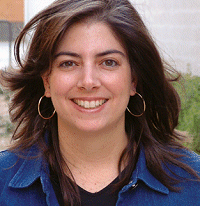Pulling in Tandem
In Part Two of our special report on vendor partnering, we look
at two community colleges and their unique approaches to
software challenges: multiple vendor partners for an online
learning materials initiative, and the vendor as scientific study
partner for an online collaboration tools pilot.
 Finding the perfect vendor partner for any campus initiative
takes more than patience and planning; it takes
an open mind. In the case of the two institutions and
their software initiative leaders profiled below, a careful
assessment of need—coupled with a good deal of
out-of-the-box thinking—led to innovative approaches
to vendor partnering for project success. Got an
upcoming software initiative that could use some help?
Throw out preconceived ideas and look for a win-win
in the technology vendor community.
Finding the perfect vendor partner for any campus initiative
takes more than patience and planning; it takes
an open mind. In the case of the two institutions and
their software initiative leaders profiled below, a careful
assessment of need—coupled with a good deal of
out-of-the-box thinking—led to innovative approaches
to vendor partnering for project success. Got an
upcoming software initiative that could use some help?
Throw out preconceived ideas and look for a win-win
in the technology vendor community.
Multiple Partners May Be The Answer
Jack Chambers is the executive director of organizational
learning services for Florida Community College at
Jacksonville where, two years ago, he and his team
dreamed up the Sirius Project—the development of lowcost
but highly interactive course materials to assist the
large number of students involved in online education.
Of FCCJ’s 46,000 students, nearly a third take courses
online on a regular basis. In addition, the college has sizable
contracts with the US Navy, which have the potential
to add an additional 24,000 students to its rolls. The
school has to date placed about 100 courses online,
including every general education course it offers. Prior
to the Sirius Project, each online course used standard
textbooks and was developed internally.
The thrust of Sirius, however, was to develop courses
that didn’t use the standard textbooks; via Sirius, the faculty
would write their own. In fact, they would be challenged
to develop the entire contents of the course—not
just the textual content, but interactive components as
well. The goals: to limit each textbook to 150 pages,
price it at $60 (including shipping), and include both a
CD and an online element for access to additional
materials such as discussion questions and interactive
tools that don’t require a lot of bandwidth for downloading.
(The CD was intended to benefit students who
don’t always have internet connectivity.)
“The idea,” says Chambers, “is that [Naval] students
at the bottom of the ocean in a submarine can still
study, because they have a CD and a book. When their
tour of duty is over or they have internet access, they
can catch up with discussion questions.”
A sizable undertaking. Still, as simple and straightforward
as the Sirius initiative may sound now, that’s
how overwhelming the details behind the venture soon
became, after the project was launched. Fact is, if
Chambers hadn’t persisted in his search for just the
right textbook publishing partner, the whole thing
might still be just an idea.
“We found out early on,” says Chambers, “that it was
going to be a difficult task.” The only way to make it work, the team decided, was to form a
partnership with a major educational
publishing company that could provide
the learning objects the courses would
need. Shortly after that realization,
Chambers met first with execs at Thomson, to share the
vision and progress of his group’s work.
“We spent a year going back and forth,
meeting with them and with their instructional
designers and the people running
their labs,” says Chambers. “But after a
year, we just couldn’t agree on a partnership.”
At the time, he says “the company
simply wasn’t ready to depart from the
traditional mode of publishing.”
First partner: Pearson. Next came discussions
with Pearson, whose execs were interested in an
instructional design course called Creating
Optimal Learning Environments
(CREOLE), which—with local funds and
a grant from the Fund for the Improvement of Postsecondary Education — FCCJ and Virginia Tech had developed
jointly over a number of years. In June
2005, a deal was struck. Through its sales
reps, Pearson would market the course to
the company’s major textbook customers;
FCCJ would promote it in the higher ed
community. The technology side of the
picture was still not nailed down, however,
so in September 2005, FCCJ put out
an “invitation to negotiate”: a statement
expressing the school’s desire to use a
technology provider’s learning objects
and software to help the school publish its
new breed of course material. That generated
a visit from McGraw-Hill Education.
McGraw-Hill comes on board.
McGraw-Hill had heard about CREOLE
and wanted to market it. Although that
part of the Sirius Project had been committed
to Pearson, the team informed the
publisher it was still seeking a partner for
another facet of the project: the learning
objects development. McGraw-Hill came
on board in June 2006. Whereas Thomson
had not been ready for the new breed
of course material development and
“Pearson was ready to try, but only on
their terms,” McGraw-Hill was “open to
trying new things,” recalls Chambers.
Timing, in effect, was everything, and by
bringing two different partners with different
agendas to the table, FCCJ was
able to launch a dream project that may
not have gotten off the ground otherwise.
Materials, marketing, and more. The
contract with McGraw-Hill lasts two-and-a-half years, says Chambers, covers
28 courses, and is renewable up to 2012.
The first four courses will be basic skills
reading, basic skills English, basic skills
math, and basic psychology.
The courses will be marketed on a
national scale by McGraw-Hill, primarily
to other community colleges that want
to get started using online materials, as
well as to small, private colleges that
want to provide this type of training to
their students. The courses can be delivered
in any of three ways: fully face-toface,
fully online, or in a blended mode.
Sales, says Chambers, are expected to be
“sizable.” The share of the revenue
returned to the school will go toward student
scholarships and into supporting the
Sirius program, in the form of adding
more instructional designers and paying
faculty stipends for developing new
courses. Chambers says he expects the
cost of course material development to be
fully covered (excluding overhead such as
his salary) during the life of the current
contract with McGraw-Hill, which has
about two years remaining.

"Stop thinking the way you’ve been taught to think in an institution," warns FCCJ’s Jack Chambers. "Start thinking more creatively, and take more risks."
As for the faculty developing the new
course materials, they can have access
to anything in the digital asset library
owned by McGraw-Hill, Chambers
asserts. And for assets leased by
McGraw-Hill, the school will pay the
same fee the publisher is charged. Faculty
will also be able to build some of the
simpler components they want to offer
in courses, such as crossword puzzles
and flashcards, using SoftChalk’s LessonBuilder. As the
course material is finished, Chambers
explains, the school will deliver cameraready
copy, then the company will print,
stock, and distribute the books.
But the partnering doesn’t end there.
McGraw-Hill has funded a full-time
instructional designer for that first twoand-
a-half-year phase of the contract.
FCCJ is using McGraw-Hill’s math software,
ALEKS and MathZone, and has set
up another contract with the publisher,
whereby the college can make those programs
available to students online.
Training for the new tools. Along with
the development of course materials and
CREOLE, Sirius encompasses another
initiative: an online program to teach faculty
how to use the tools, and pedagogical
methods to construct course materials.
This part of Sirius has proven to be wildly
successful, according to Chambers.
Nearly 400 faculty members are participating
in the learning process, which
takes from a year-and-a-half to two years
to complete. A $500 incentive is paid out
to adjunct faculty who complete the training;
for tenured faculty, their departments
receive the honoraria. About 100 instructors
have completed the courses, Chambers reports, and about a third of the fulltime
faculty at the school have volunteered
for the training. The training, of
course, brings its own rewards: After all,
it prepares faculty to tackle the development
of their own course materials. Once
trained, teams of four are assigned to the
development of a given course, with eight
courses in development at a time. Initially,
the team leader receives $4,500 and
each team member gets $3,500. If the
team completes the entire course within
four semesters—including teaching it in
beta form, then modifying it based on the
results of the beta—each person receives
an additional $500. As added motivation,
three outside academicians familiar with
different areas of higher ed will form a
judging panel during that phase, to rate
which one of the eight courses is the most
creative and best engages the student. The
winning team will receive an additional
$500 per person.
The initial funding for the program
came from several grants handed out by
FCCJ’s Strategic Planning Council, a
group of 35 individuals who represent
administrators, faculty, students, and
other campus constituencies. The council
meets quarterly and manages a budget of
a million dollars a year, says Chambers; it
doles out those funds to worthwhile proposals,
in increments of up to $150,000.
For other schools looking to enhance
their own online programs through similar
course material development projects,
Chambers offers these words of advice
about building successful partnerships:
“Stop thinking the way you’ve been
taught to think in an institution,” he
warns. Instead, “You have to start thinking
more creatively, and take more risks.
The biggest problem I see is the lack of
risk taking—saying, ‘This is the way it’s
been for the last 500 years and this is the
way it should always be.’ If you start with
that thought, then you won’t do these
things, which are very high-risk.”
The Vendor as Scientific Study Partner
At GateWay Community College in
Phoenix, AZ, Lisa Young is program
director of water resources, and also
serves as eLearning coordinator for the
institution. Young evaluated a number of
companies before settling on a partner
vendor for an online collaboration service
she envisioned setting up within her district.
Even now, she says, her decision
isn’t final—that is, unless results from her
study of the implementation help her to
conclude that it’s worthwhile.
Special challenges. Young has a
unique set of students at GateWay Community
College (one of 10 schools that
make up Arizona’s Maricopa Community
College District). They’re signed up
to take her hydrology or water treatment
courses, yet they frequently work in water
treatment plant jobs where their shifts
change on a monthly basis. That means
that Young’s students may not work the
same days each week. One month, a student
might work a graveyard shift; the
next month, it might be a daytime shift.
Expecting students to show up on campus
for her classes on a set day at a set time is
unrealistic, the instructor admits. And
though online courses might be a solution
to the dilemma, Young considers most
online content “highly text-driven”—
insufficient for classes that involve
teaching students how to use expensive
software and specialized equipment.
What’s more, the scheduling problems
of online courses only add to her students’
frustration and her own, she says.
“If they have to wait for an e-mail from
me,” she confides, “that can cost them a
whole day of learning.”
Online collaboration tools. As the
eLearning coordinator at the college,
Young decided to examine other means
for providing the face-to-face instruction
she felt her students deserved (or as close
as she could get to face-to-face). That led
her to write a funding proposal for a
proof-of-concept initiative involving web
conferencing tools that would enable
online collaboration. The purpose of the
study: to evaluate how collaboration tools
can be used not for faculty and staff meetings,
but for academic purposes—strictly
teaching and learning. Young looked at
many products, including the collaboration
tools offered by Blackboard, provider of the course
management system that was being used
in seven of the 10 colleges in the district.
Enter Elluminate. Young settled on
Elluminate Live!, from Elluminate (www.
elluminate.com). What sold her was the
fact that the software was designed
specifically for academic use. She’s able
to record her lectures (including what
appears on her computer and on the
whiteboard) so that students can view
them on their own time. That same
whiteboarding feature can be used to
permit students to meet with faculty
during virtual office hours. “This allows
me to schedule tutoring sessions with
[students], whether it’s 2 am or 11 am,”
she says. “So I’m planning to use it to
get more interaction with them.”
True application sharing. On the
hydrology side of her teaching, what
most excites her is Elluminate’s ability
to give students access to specialized
and quite expensive geographic information
system (GIS) software that, traditionally,
students have only been able
to use in the school’s computer labs during business hours. Restricted access
limited students’ ability to get their
homework done. “With Elluminate’s
application sharing, [students will] be
able to show me where they’re stuck,
using my version of GIS software on my
computer,” says Young. “I can give them
control of the software through their
computer, then I can take control and
show them the right way, or talk them
through it while they’re still [viewing
what’s happening on] my computer.”
Reaching out to the district. In her role
as a member of Ocotillo, a faculty subgroup
of the district’s Maricopa Center
for Learning and Instruction (MCLI is
involved in researching and imparting
information on instructional technologies
to the faculty), Young had presented the
collaboration idea to MCLI. In fact, it
was through that organization that she
arranged to purchase an Elluminate
license for her school. And it was at that
point that she began looking at the project
from a district perspective: How could
the study be structured to evaluate the
collaboration efforts of other faculty
members? Young then contacted each of
the district’s 10 schools, asking administrators
at each to provide at least one
contact who would act as a liaison to
help recruit faculty to expand the study.
Young invited her new group of delegates
to participate in training on the
Elluminate software.

Lisa Young found an online collaboration solution that records lecture content, plus allows for virtual student/faculty meetings 24/7.
Once the delegates were up to speed,
she expanded the initiative with an open
call to faculty, districtwide; her campus
contacts sought out those individuals in
their schools who were interested in participating
in the study to find out how it
could impact instruction more broadly.
Young held three two-hour sessions, in
person, with interested faculty throughout
the district. In those workshops, she
explained what Elluminate was, how it
could be used, what the time commitment
would be, etc. Then she invited session
attendees to submit proposals detailing
how they’d like to implement Elluminate
in their own classrooms.
Though Young hoped to attract 10 to 15
meeting attendees, she was delighted
when 70 turned up. Almost two-thirds of
the attendees (over 40) later submitted
proposals. At the time of this writing,
Young reports that nearly 50 faculty
members have participated in the study
for the spring ’07 semester. She expects
to schedule pilot projects in three phases:
spring, summer, and fall.
Working relationship. Through the
entire experience of experimenting with
the software and expanding the scope of
the testing across other schools, Young
says, Elluminate has been an outstanding
partner. “They’ve been fantastic in
providing us with training, have helped
us select required hardware, and they’re
available to help us as needed. We’re
definitely working [on this project]
together.” In addition, she says, the vendor
has helped her and her district peers
to connect with academic users nationwide
who have used Elluminate for other
distinct purposes. For all of the vendor’s
helpfulness, Young maintains, she also
appreciates the fact that she can easily
point out what she doesn’t need. “Of
course, we want their support as our vendor.
But I’m doing a study and, sometimes,
they’re willing to help us more
than we can accept. To make sure the
study remains objective, at some point
we have to say, ‘Thank you so much, but
we need to do this part on our own.’ ”
Recommendations. Young’s advice to
others seeking to make a pilot project
partner of a vendor: “Be honest. Let them
know what you’re trying to do, what your
needs are, what your objectives are, what
support you need from them in order to
make it a solid scientific study, and what
you don’t need from them, as well.”
:: WEBEXTRA :: Miss Part 1 of this feature? Find it online here :: Partnering to help one community college bounce back from Hurricane Katrina.
About the Author
Susan D. Heid writes about organizational
transformation for a number of
publications in various sectors.